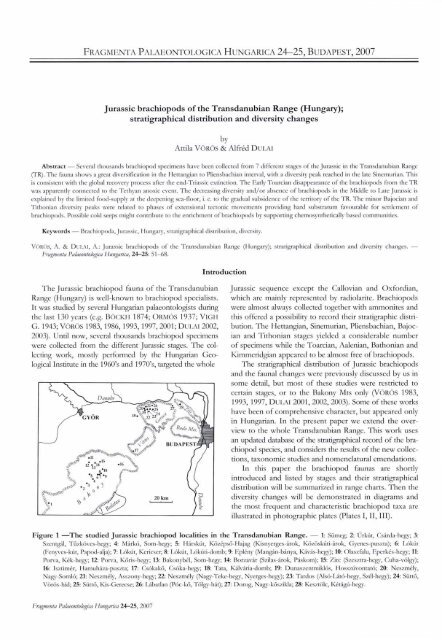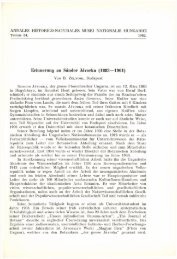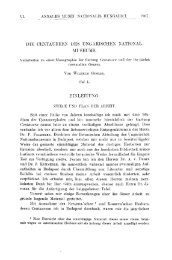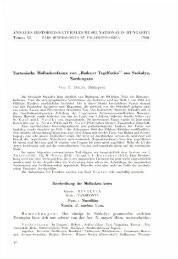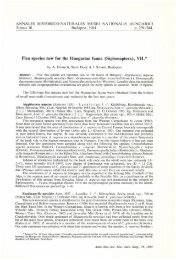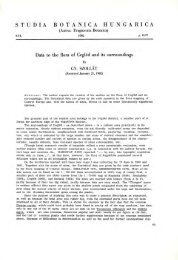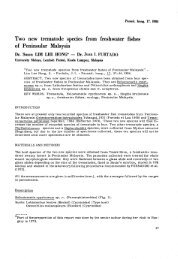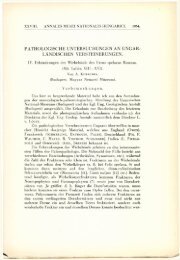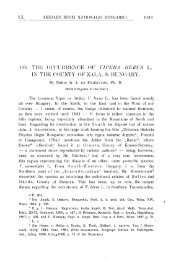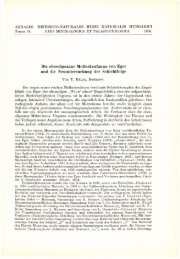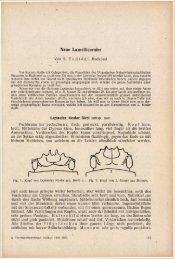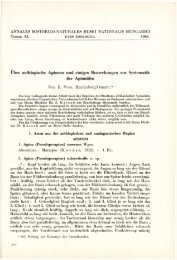Fragmenta Mineralogica Et Palaentologica 24-25. 2007. (Budapest ...
Fragmenta Mineralogica Et Palaentologica 24-25. 2007. (Budapest ...
Fragmenta Mineralogica Et Palaentologica 24-25. 2007. (Budapest ...
You also want an ePaper? Increase the reach of your titles
YUMPU automatically turns print PDFs into web optimized ePapers that Google loves.
FRAGMENTA PALAEONTOLOGICA HUNGARICA <strong>24</strong>—25, BUDAPEST, 2007<br />
Jurassic brachiopods of the Transdanubian Range (Hungary);<br />
stratigraphical distribution and diversity changes<br />
by<br />
Attila VÖRÖS & Alfréd Du LAI<br />
Abstract — Several thousands brachiopod specimens have been collected from 7 different stages of the Jurassic in the Transdanubian Range<br />
(TR). The fauna shows a great diversification in the Hettangian to Pliensbachian interval, with a diversity peak reached in the late Sinemurian. This<br />
is consistent with the global recovery process after the end-Triassic extinction. The Early Toarcian disappearance of the brachiopods from the TR<br />
was apparently connected to the Tethyan anoxic event. The decreasing diversity and/or absence of brachiopods in the Middle to Late Jurassic is<br />
explained by the limited food-supply at the deepening sea-floor, i. e. to the gradual subsidence of the territory of the TR. The minor Bajocian and<br />
Tithonian diversity peaks were related to phases of extensional tectonic movements providing hard substratum favourable for settlement of<br />
brachiopods. Possible cold seeps might contribute to the enrichment of brachiopods by supporting chemosynthetically based communities.<br />
Keywords — Brachiopoda, Jurassic, Hungary, stradgraphical distribution, diversity.<br />
VÖRÖS, A. & DULAI, A.: Jurassic brachiopods of the Transdanubian Range (Hungary); stratigraphical distribution and diversity changes. —<br />
<strong>Fragmenta</strong> Palaeontologica Hungarica, <strong>24</strong>—25: 51-68.<br />
The Jurassic brachiopod fauna of the Transdanubian<br />
Range (Hungary) is well-known to brachiopod specialists.<br />
It was studied by several Hungarian palaeontologists during<br />
the last 130 years (e.g. BÖCKH 1874; ORMÓS 1937; VlGH<br />
G. 1943; VÖRÖS 1983,1986,1993,1997,2001; DULAI 2002,<br />
2003). Until now, several thousands brachiopod specimens<br />
were collected from the different Jurassic stages. The col<br />
lecting work, mostly performed by the Hungarian Geo<br />
logical Institute in the 1960's and 1970's, targeted the whole<br />
Introduction<br />
Jurassic sequence except the Callovian and Oxfordian,<br />
which are mainly represented by radiolarite. Brachiopods<br />
were almost always collected together with ammonites and<br />
this offered a possibility to record their stratigraphie distri<br />
bution. The Hettangian, Sinemurian, Pliensbachian, Bajoc<br />
ian and Tithonian stages yielded a considerable number<br />
of specimens while the Toarcian, Aalenian, Bathonian and<br />
Kimmeridgian appeared to be almost free of brachiopods.<br />
The stratigraphical distribution of Jurassic brachiopods<br />
and the faunal changes were previously discussed by us in<br />
some detail, but most of these studies were restricted to<br />
certain stages, or to the Bakony Mts only (VÖRÖS 1983,<br />
1993, 1997, DULAI 2001, 2002, 2003). Some of these works<br />
have been of comprehensive character, but appeared only<br />
in Hungarian. In the present paper we extend the over<br />
view to the whole Transdanubian Range. This work uses<br />
an updated database of the stratigraphical record of the bra<br />
chiopod species, and considers the results of the new collec<br />
tions, taxonomic studies and nomenclatural emendations.<br />
In this paper the brachiopod faunas are shortly<br />
introduced and listed by stages and their stratigraphical<br />
distribution will be summarized in range charts. Then the<br />
diversity changes will be demonstrated in diagrams and<br />
the most frequent and characteristic brachiopod taxa are<br />
illustrated in photographic plates (Plates I, II, III).<br />
Figure 1 —The studied Jurassic brachiopod localities in the Transdanubian Range. — 1: Sümeg; 2: Úrkút, Csárda-hegy; 3:<br />
Szentgál, Tűzköves-hegy; 4: Márkó, Som-hegy; 5: Hárskút, Középső-Hajag (Kisnyerges-árok, Közöskútí-árok, Gyenes-puszta); 6: Lókút<br />
(Fenyves-kút, Papod-alja); 7: l.ókút, Kericser; 8: Lókút, Lókúti-domb; 9: Eplény (Mangán-bánya, Kávás-hegy); 10: Olaszfalu, Eperkés-hegy; 11:<br />
Porva, Kék-hegy; 12: Porva, Kőris-hegy; 13: Bakonybél, Som-heg)'; 14: borzavar (Szilas-árok, Páskom); 15: Zirc (Szesztra-hegy, Cuha-völgy);<br />
16: Iszdmér, Hamuháza-puszta; 17: Csókakő, Csóka-hegy; 18: Tata, Kálvária-domb; 19: Dunaszentmiklós, Hosszúvontató; 20: Neszmély,<br />
Nagy-Somló; 21: Neszmély, Asszony-heg)-; 22: Neszmély (Nagy-Teke-hegy, Nyerges-heg) 7<br />
); 23: Tardos (Alsó-Látó-hegy, Szél-heg)'); <strong>24</strong>: Süttő,<br />
Vörös-híd; 25: Süttő, Kis-Gerecse; 26: Lábatlan (Póc-kő, Tölgy-hát); 27: Dorog, Nagy-kőszikla; 28: Kesztölc, Kétágú-heg)'.
SPECIES<br />
Cirpa aff. plunifrons<br />
Liospiriferina cf. pichleri<br />
Lobothyris ovatissimaeformis<br />
Lobothyris ? sospirolensis<br />
fakubirhynch ta Uitifrons<br />
Saleireila cf. albertii<br />
Cuneirhynchiu cartieri<br />
Lobothyris ? subgregaria<br />
Zeilleriu perforata<br />
Rhapidothyris ? complanata<br />
Calcirhynchia ? plicatissima<br />
Lobothyris andleri<br />
L iospiriferina alpin a<br />
Zeilleriu mtitabilis<br />
Cirpa fron to<br />
Calcirhynchia aff. plicatissima<br />
Calcirhynchia zugmuyeri<br />
Piarorhynchia ? caroli<br />
L iospiriferina aequiglobuta<br />
Liospiriferina ? guembeli<br />
Liospiriferina monconii<br />
Liospiriferina aff. obtusu A.<br />
Phymatothyris aff. cerusulum<br />
Zeilleriu cor<br />
Zeilleria aff. venusta<br />
Rhytt ch 011 ellin n h of mann i<br />
Rhynchonellinu suessi<br />
Prionorhynchiu greppini<br />
Prionorhynch iu pseudopolyptych a<br />
Cirpa variabilis<br />
Homoeorhynchia ? prona<br />
Cun eirh] ch i u fruits i<br />
Cuneirhynchiu retusifrons<br />
Pisirh yttchiu inversa<br />
Gibbirhynchia ? urkutica<br />
Prionorhynchiu ? triquetra<br />
Liospiriferin a acuta<br />
Liospiriferina urudusi<br />
Cisn erospiru ungit la tu<br />
Ci su erospiru sylvia<br />
C "ullosp ir if er ii t u tu inula<br />
Rhapidothyris '! cf. beyrichi<br />
Zeilleriu butillu<br />
Zeilleria choffuti<br />
Zeilleria venusta<br />
Securina partschi<br />
Bakon yith y ris ewaldi<br />
Gibbirhynchia orsinii<br />
l'r ion or h \ nchia polyptych u<br />
Cirpa s u bcostellata<br />
Calcirhynchia fascicostata<br />
Gibbirhynchia curviceps<br />
Liospiriferin a ohms a<br />
Dispiriferin a s egregutu<br />
Rhapidothyris ? ovimontana<br />
Linguithyris linguuta<br />
Zeilleria alpin a<br />
Zeilleria cf. livingstonei<br />
Pisirhyn chia pisoides<br />
Pisirhynchiu retroplicutu<br />
[pringia puolii<br />
Liospiriferin u brevirostris<br />
Liospiriferin u gryphoidea<br />
Liospiriferin a siculu<br />
Cisnerospira cf. darwini<br />
L oboth\ 'ris pu n et at a<br />
intiptychina ? rothpletzi<br />
Bukonyithyris pedenwntun u<br />
Linguithyris aspasia<br />
H SI S2 PI P2 Tl SPECIES H SI S2 PI P2 Tl<br />
Rhynchonellinu ? renevieri<br />
Prionorhynchia forticostata<br />
Prionorhynchiu pseudoscherinu<br />
Prionorhynchiu ? telegdirothi<br />
Cirpa planifions<br />
Calcirhynchia ? mutyasovszkyi<br />
Calcirhynchia ? rintatu<br />
Sulgirellu ? magnicostutn<br />
Cuneirhynchiu dulmusi<br />
Sunn irh) m ch iu pi lui lu<br />
Pisirhynchiu ? ultligi<br />
Furcirhynchia emmrichi<br />
Liospiriferin u cuntianensis<br />
Liospiriferin u aff. obtusu B<br />
Papodina ? himuntmuta<br />
Papodina ju vavica<br />
Lobothyris ? grestenensis<br />
Phymatothyris ? radis<br />
Fimbriothyris ? foetterlei<br />
Zeilleria aff. buldaccii<br />
Zeilleriu catharinae<br />
Zeilleria engelh urdti<br />
Zeilleriu h er en dieu<br />
Zeilleriu s tupi u<br />
Securina securiformis<br />
Calcirhynchia ? Inevicosta<br />
Homoeorhynchiu ? htbricu<br />
Cun eirhyn ch in pulntutu<br />
Pisirhyn chiu men eg h inii<br />
Gibbirhynchia ? sordellii<br />
Zeilleriu waehneri<br />
. [mphiclinodontu liusina<br />
Koninckodontu waehneri<br />
Orthotoma apenninica<br />
Apringia al tes inu a ta<br />
. [pringia piccininii<br />
Apringia diptychu<br />
Prionorhynchiu ? ftubellum<br />
Prionorhynchia ? hugaviensis<br />
Lokutellu liasina<br />
Papodina bittneri<br />
Phi-matothy -ris cerasu lu m<br />
Zeilleria bicolor<br />
Securina h ierlatzica<br />
Bukonyithyris upenn inica<br />
Apringia deltoidea<br />
Prionorhynchiu aff. greppini<br />
Lokutellu kondai<br />
Cuneirhynchiu cf. rastuensis<br />
Pisirhynchiu ? aff. uhligi A<br />
Kericserellu inversueformis<br />
Gibbirhynchia ? aff. urkutica<br />
Liospiriferina cf. h an deli<br />
Liospiriferina cf. globosa<br />
Securithyris paronai<br />
Hesperithyris ? cf. costata<br />
Uesperithyris ? aff. renierii<br />
. intiptychina ? belhtnensis<br />
Aulacothyris ? amygdaloides<br />
Bukonyithyris uvicttlu<br />
Bukonyithyris meneghinii<br />
[pringia ? aff. piccininii<br />
Lokutellu pnlmueformis<br />
Xannirhynchia gemmellaroi<br />
Kon in ckodon ta fit g g eri<br />
Cisnerospira meneghiniana<br />
Liospiriferin u upenn inica<br />
I iullithyris gozzanensis<br />
Securithyris udneth ens is<br />
Figure 2 — Stratigraphical distribution of the brachiopod species in the Early Jurassic of the Transdanubian Range.<br />
H: Hettangian, SI: Early Sinemurian, S2: Late Sinemurian, PI: Early Pliensbachian, P2: Late Pliensbachian, Tl: Early Toarcian.
S P E C I E S H SI S2 PI P2 Tl<br />
Securithyris fitos a<br />
Hesperithyris renierii<br />
IIesperithyris cf. pacheia<br />
Lychn othyris rotzoana<br />
Zeilleria oenana<br />
Zeilleriu uquilinu<br />
Aulacothyris ? cf. fuggeri<br />
Bukonyithyris ovimontana<br />
Apringia fraudatrix<br />
Apringia ? cf. suetii<br />
Apringia ? stoppanii<br />
Apringia ? atlaeformis<br />
Pseudogibbirhynchia ? aff. verra<br />
Prionorhynchia ? aff. ftabellum<br />
Cirpa ? Cf. subfurcillata<br />
Homoeorhynchia acuta<br />
Pisirhynchiu ? aff. uhligi B<br />
Pisirhynchiu ? aff. uhligi ( '<br />
Pisirhynchiu ? aff. uhligi D<br />
Nan nirh) n ch ia sit utat a<br />
Nannirhynchia ? bulga<br />
Nannirhynchia ? aff. bulga<br />
Koninckodonta aff. fuggeri<br />
Koninckodonta ? aff. ulfurica<br />
Liospiriferina cf. obovata<br />
Orthotoma aff. apenninica<br />
Rhapidothyris ? aff. beyrichi<br />
I talüthyris ? delorenzoi<br />
Linguithy'rá cornico/ AM«<br />
Antiptych'ma ? aff. gastaldii<br />
Aulacothyris ? baUinensis<br />
Bukonyithyris ? aff. ovimontana<br />
This stage is represented by the lithologically rather uniform,<br />
oncoidal-ooidal shallow marine Kardosrét Limestone<br />
in the Bakony Mountains. The list of its brachiopods was<br />
published by MICHALIK et al. (1991) and DULAI (1993). In<br />
the other areas, the Hettangian is usually missing due to a<br />
sedimentary 7<br />
gap, except in the Kálvária-domb at Tata,<br />
where Upper Hettangian pelagic limestone with ammonoids<br />
was recorded (FÜLÖP 1976, GÉCZY 1976a). A recent, bedby-bed<br />
collection of limited extent complemented the<br />
]akubirhynchia latifrons (GEYER, 1889)<br />
Cirpa aff. planifrons (ORMÓS, 1937)<br />
Calcirhynchia ? plicatissima (QUENSTEDT, 1852)<br />
Salgirella cf. alberta (OPPEL, 1861)<br />
Cuneirhynchia cartieri (OPPEL, 1861)<br />
Uospiriferina cf. alpina (OPPEL, 1861)<br />
Liospiriferina cf. pichleri (NEUMAYR, 1879)<br />
After a sudden change in sedimentation, this stage is<br />
represented by deeper water pelagic sedimentary rocks all<br />
over the TR: pink and yellowish limestones (Pisznice Formation),<br />
crinoidal and cherty limestones (Isztimér Formation)<br />
and coarse biodetrital, mosdy sparitic limestones (Hierlatz<br />
Formation). The latter is exceptionally rich in brachiopods.<br />
Their faunas have been known for a long time (BÖCKH<br />
1874, VIGH GY. 1913, ORMÓS 1937, VlGH G. 1943).<br />
Jurassic brachiopods of the Transdanubian Range (Hungary)<br />
Jurassic brachiopods of the Transdanubian Range<br />
Abundant and diverse brachiopod faunas are known<br />
from several parts of the territory of the Transdanubian<br />
Range (TR); first of all from numerous sites in the Bakony<br />
Mountains, from the Vértes (Csóka-hegy near Mór), the<br />
Gerecse Mountains (e. g. the Kálvária-domb in Tata, and<br />
several localities in the western part of the Gerecse), and<br />
from the Pilis Mountains (Figure 1).<br />
The localities in the Bakony are of outstanding importance<br />
from several points of view: (1) Here rich faunas<br />
occur from most of the stages of the Jurassic, whereas in<br />
the other mountains only the Sinemurian, Bajocian and<br />
Tithonian stages yielded significant brachiopod assemblages.<br />
(2) At the Bakony localities the abundant faunas<br />
have been collected bed-by-bed, together with ammonoids,<br />
offering an excellent opportunity 7<br />
to constrain their stratigraphic<br />
ranges, since the stratigraphie evaluation of the<br />
ammonoid faunas was carried out by GÉCZY (1971a,<br />
1971b, 1972a, 1972b, 1974, 1976b), GALÁCZ (1976, 1980,<br />
1995) and FŐZY (1987, 1988, 1993). (3) Partly for the above<br />
reasons, the systematic research of the brachiopods of the<br />
Bakony localities is in a more advanced state.<br />
y one of us (AV); these identifications are included in the<br />
present work.<br />
The profuse brachiopod faunas of the western Gerecse<br />
Mountains (Asszony-hegy, Nagysomlyó, Hosszúvontató,<br />
Teke-hegy) were described and illustrated in details by G.<br />
VlGH (1943). Recently we made new collections in many<br />
localities and partly revised VlGH's identifications (DULAI<br />
1998a, 1998b, 2003).<br />
In the Pilis Mountains, the neptunian dykes at Kétágúhegy<br />
provided rich faunas which were described, but not<br />
illustrated, by GY. VlGH (1913). We re-examined the brachiopods<br />
housed in the Museum of the Hungarian Geological<br />
Institute.<br />
The above faunas are usually very rich but the old<br />
bulk collections are not precisely dated by ammonoids,<br />
therefore they are regarded generally as Sinemurian<br />
without attribution to substage.<br />
The Sinemurian brachiopods of the Bakony Mountains<br />
are more precisely dated, therefore their division into an<br />
Early and a Late Sinemurian association is possible.<br />
Ammonoid stratigraphy was developed only in a few<br />
Ljower Sinemurian sections (Lókúti-domb: GÉCZY 1972a,<br />
Apringia piccininii (ZlTTEL, 1869)<br />
Apringia paolii (CANAVARI, 1880)<br />
Apringia altesinuata (BÖSE, 1898)<br />
Apringia diptycha (BÖSE, 1898)<br />
Rhynchonellina suessi GEMMELLARO, 1871<br />
Rhynchonellina hofmanni (BÖCKH, 1874) (Plate I: 7a-b)<br />
Rhynchonellina ? renevieri (HAAS, 1884)<br />
Prionorhynchia greppini (OPPEL, 1861)<br />
Prionorhynchiapoljptycha (OPPEL, 1861) (Plate I: 8a-b)<br />
Prionorhynchia pseudopolyptycha (BÖCKH, 1874)<br />
Prionorhynchia forticostata (BÖCKH, 1874) (Plate I: lOa-b, 11 a-b)<br />
Prionorhynchia pseudoscherina (BÖSE, 1898)<br />
Prionorhynchia ? triquetra (GEMMELLARO, 1874)<br />
Prionorhynchia ? flabellum (GEMMELLARO, 1874) (Plate I: 9a-b)<br />
Prionorhynchia ? hagaviensis (BÖSE, 1898)<br />
Prionorhynchia ? telegdirothi (ORMÓS, 1937)<br />
Lokutella Hasina (PRINCIPI, 1910)<br />
Jakubirhyncbia latifrons (GEYER, 1889)<br />
Cirpa variabilis (SCHLOTHEIM, 1813)<br />
Cirpa fronto (QUENSTEDT, 1871)<br />
Cirpa subcostellata (GEMMELLARO, 1878) (Plate I: 12a-b)<br />
Cirpaplanifrons (ORMÓS, 1937)<br />
Calcirhynchiafascicostata (UHLIG, 1879) (Plate I: 16a^b)<br />
Calcirhynchia yugmayeri (GEMMELLARO, 1878)<br />
Calcirhynchia ? plicatissima (QUENSTEDT, 1852) (Plate I: 14a-b)<br />
Calcirhynchia aff. plicatissima (QUENSTEDT, 1852)<br />
Calcirhynchia ? laevtcosta (GEYER, 1889) (Plate I: 15)<br />
Calcirhynchia ? matyasovsykyi (BÖCKH, 1874)<br />
Calcirhynchia ? rimata (OPPEL, 1861)<br />
Salgirella albertii (OPPEL, 1861) (Plate I: 17a-b, 18)<br />
Salgirella ? magnicostata (ORMÓS, 1937)<br />
hlomoeorhynchia ? prona (OPPEL, 1861)<br />
Homoeorhynchia ? lubrica (UHLIG, 1879)<br />
Cuneirhynchiapalmata (OPPEL, 1861) (Plate I: 21)<br />
Cuneirhynchia cartieri (OPPEL, 1861) (Plate 1: 20a-b)<br />
Cuneirhynchia fraasi (OPPEL, 1861)<br />
Cuneirhynchia retusifrons (OPPEL, 1861) (Plate I: 19a-b)<br />
Cuneirhynchia dalmasi (DUMORTIER, 1869)<br />
Piarorhynchia ? caroli (GEMMELLARO, 1878)<br />
Nannirhynchia pilulla (BÖSE & SCHLOSSER, 1900)<br />
Pisirhynchia inversa (OPPEL, 1861) (Plate I: 22a-b)<br />
Pisirhynchia pisoides (ZlTTEL, 1869)<br />
Pisirhynchia retroplicata (ZlTTEL, 1869)<br />
Márkó, Som-hegy: DULAI 2002). At these localities,<br />
detailed collection for brachiopods was carried out. The<br />
Lower Sinemurian Pisznice Limestone (Lókúti-domb:<br />
DULAI 1990, 1992) yielded 400 specimens, whereas from<br />
the Isztimér Formation (Márkó, Som-hegy: DULAI 2002,<br />
2003) 800 specimens were collected. Most of the typical<br />
Hierlatz Limestone occurrences are attributed to the<br />
Upper Sinemurian, partly on the basis of ammonoids (Szentgál,<br />
Tűzköves-hegy: GÉCZY 1974; Olaszfalu, Eperkéshegy:<br />
GÉCZY, pers. comm.). Some other, very abundant<br />
"Hierlatz-type faunas" (Úrkút, Csárda-hegy; Porva, Kékheg}')<br />
were arbitrarily inferred as Upper Sinemurian by<br />
considering lithological and faunal analogies. Nearly<br />
10,000 brachiopod specimens have been collected from<br />
these localities and are kept in the collections of the<br />
Hungarian Natural History Museum. Here we present a<br />
summarized list of the Sinemurian brachiopods, while in<br />
range chart (Figure 2) the Early and Late Sinemurian occurrences<br />
are distinguished.<br />
The list of brachiopod species recorded from the<br />
Sinemurian of the TR (their stratigraphical distribution is<br />
shown in a range chart, in Figure 2):<br />
Pisirhynchia meneghinii (ZlTTEL, 1869)<br />
Pisirhynchia ? uhligi (HAAS, 1884)<br />
b'urcirhynchia emmrichi (OPPEL, 1861)<br />
Gibbirhynchia curviceps (QUENSTEDT, 1852)<br />
Gibbirhynchia orsinii (GEMMELLARO, 1874)<br />
Gibbirhynchia ? sordellii (PARONA, 1880) (Plate I: 23a-b)<br />
Gibbirhynchia ? urkutica (BOCKH, 1874)<br />
liospiriferina obtusa (OPPEL, 1861) (Plate I: <strong>24</strong>, 25a-b)<br />
liospiriferina aff. obtusa (OPPEL, 1861) A<br />
Liospiriferina aff. obtusa (OPPEL, 1861) B<br />
liospiriferina alpina (OPPEL, 1861)<br />
Liospiriferina brevirostris (OPPEL, 1861)<br />
Liospiriferina sicula (GEMMELLARO, 1874)<br />
Liospiriferina aradasi (GEMMELLARO, 1878)<br />
Liospiriferinagryphoidea (UHLIG, 1879)<br />
liospiriferina cantianensis (CANAVARI, 1881)<br />
Liospiriferina moriconii (CANAVARI, 1883)<br />
Liospiriferina acuta (GEYER, 1889)<br />
Liospiriferina aequiglobata (UHLIG, 1900)<br />
Liospiriferina ? guembeli (NEUMAYR, 1879)<br />
Cisnerospira angulata (OPPEL, 1861) (Plate I: 27a-b)<br />
Cisnerospira sylvia (GEMMELLARO, 1878)<br />
Cisnerospira cf. darwini (GEMMELLARO, 1878)<br />
Callospiriferina tumida (BUCH, 1836) (Plate 1: 26a-b)<br />
Dispiriferina segregata (Dl STEFANO, 1886)<br />
Amphiclinodonta Hasina BlTTNER, 1888<br />
Koninckodonta waehneri (BlTTNER, 1894)<br />
Orthotoma apenninica (CANAVARI, 1883)<br />
lobothyris punctata (SOWERBY, 1812)<br />
luobothyris andleri (OPPEL, 1861)<br />
/ jobothyris ? grestenensis (SUESS, 1854)<br />
Lobothyris ? subgregaria (DAL PlAZ, 1909)<br />
Rhapidothyris ? beyrichi (OPPEL, 1861) (Plate I: 31)<br />
Rhapidothyris ? complanata (BÖCKH, 1874)<br />
Rljapidothyris ? ovimontana (BÖSE, 1898)<br />
Phymatothyris cerasulum (Z ITTEL, 1869)<br />
Phymatothyris tât. cerasulum (ZlTTEI,, 1869)<br />
Phymatothyris ? rudis (GEMMELLARO, 1874)<br />
linguithyris aspasia (ZlTTEL, 1869) (Plate I: 28a-b, 29)<br />
IJnguithyris linguata (BÖCKH, 1874) (Plate I: 30)<br />
Papodina bittneri (GEYER, 1889)<br />
Papodina juvavica (GEYER, 1889)<br />
Papodina ? bimammata (ROTHPLETZ, 1886)
Vimbriothyris ? foetterkt (BÖCKH, 1874) (Plate I: 32a-b)<br />
Zeilleria cor (LAMARCK, 1819)<br />
Zeilleria perforata (PlETTE, 1856)<br />
Zeilleria mutabilis (OPPEL, 1861) (Plate I: 6)<br />
Zeilleria engelhardti (OPPEL, 1861)<br />
Zeillena stapia (OPPEL, 1861) (Plate I: 34)<br />
Zeilleria aff. baldaccii GEMMELLARO, 1874<br />
Zeilleria herendica (BÖCKI I, 1874)<br />
Zeilleria cf. Hvingstonei GEMMELLARO, 1878<br />
Zeilleria catharinae GEMMELLARO, 1878<br />
Zeilleria waehneri GEMMELLARC), 1878 (Plate I: 5a—b)<br />
Zeilleria venusta (UHLIG, 1879) (Plate I: 36a-b)<br />
This stage is well-known in the Bakony Mountains and<br />
many aspects of its lithology and fauna was studied (KON-<br />
DA 1970, GÉCZY 1971a, VÖRÖS 1983, 1986). Dozens of<br />
sections have been excavated and collected bed-by-bed by<br />
the workers of the Hungarian Geological Institute. The<br />
ammonoid biostratigraphy was worked out and published<br />
by GÉCZY (1971a, 1971b, 1976b) and GÉCZY & MEISTER<br />
(1998). Four different lithofacies, representing different<br />
palaeoenvironments, yielded nearly 6000 brachiopod specimens:<br />
(1) condensed, dark red, manganiferous micritic limestone;<br />
(2) coarse biodetrital, sparitic Hierlatz, limestone; (3)<br />
crinoidal and cherty limestone (Isztimér Formation); (4) red<br />
nodular limestone of "rosso ammonitico" type (Tűzkő vesárok<br />
Formation) (VÖRÖS 1986).<br />
The other parts of the TR yielded less abundant brachiopod<br />
faunas; in most cases their stratigraphie position<br />
remains uncertain.<br />
Apringia piccininii (ZlTTEL, 1869) (Plate II: la-b)<br />
Apringia deltoidea (CANAVARI, 1880)<br />
Apringiapao/ii (CANAVARI, 1880) (Plate II: 2a-b)<br />
Apringia diptycha (BÖSE, 1898) (Plate II: 3a-b)<br />
Apringiafraudatrix (BÖSE, 1898) (Plate II: 8a-b)<br />
Apringia ? aff. piccininii (ZlTTEL, 1869)<br />
Apringia ? cf. suetii (HAAS, 1884) (Plate II: 7a-b)<br />
Apringia ? stoppanii (PARONA, 1880) (Plate II: 4a-b)<br />
Apringia ? altesinuata (BÖSE, 1898) (Plate II: 5a-b, 6a-b)<br />
Apringia ? atlaeformis (BÖSE, 1898)<br />
Prionorhynchia po/yptycha (OPPEL, 1861)<br />
Prionorhynchia aff. greppini (OPPEL, 1861)<br />
Prionorhynchia ? flabellum (GEMMELLARO, 1874) (Plate II: 9a-b)<br />
Prionorhynchia ? aff. flabellum (GEMMELLARO, 1874)<br />
Prionorhynchia ? hagaviensis (BÖSE, 1898)<br />
lokutella Hasina (PRINCIPI, 1910) (Plate II: 11 a-b)<br />
Lokutellapalmaeformis (HAAS, 1912) (Plate IT: lOa-b)<br />
lokutella kondai'VÖRÖS, 1983<br />
Pseudogibbirhynchia ? aff. verrii (PARONA, 1883)<br />
Cirpa ? cf. subfurcillata (BÖSE, 1898)<br />
Cirpa ? subcostellata (GEMMELLARO, 1878)<br />
Calcirhynchia ? plicatissima (QUENSTEDT, 1852)<br />
Calcirhynchia ? cf. fascicostata (UHLIG, 1879)<br />
Calcirhynchia ? laevicosia (GEYER, 1889)<br />
Homoeorhynchia acuta (SOWERBY, 1816)<br />
Homoeorhynchia ? lubrica (UHLIG, 1879)<br />
Cuneirhynchia palmata (OPPEL, 1861)<br />
Cuneirhynchia cf. rastuensis BENIGNI, 1978<br />
Pisirhynchiapisoides (ZlTTEL, 1869) (Plate II: 12a-b)<br />
Pisirhynchia retroplicata (ZlTTEL, 1869) (Plate II: 13a-b, 14a-c)<br />
Pisirhynchia meneghinii (ZlTTEL, 1869)<br />
Pliensbachian<br />
Zeilleria aff. venusta (UHLIG, 1879) (Plate I: 35a-b)<br />
Zeilleria choffati (HAAS, 1884)<br />
Zeilleria alpina (GEYER, 1889) (Plate I: 33a-b)<br />
Zeilleria barilla (GEYER, 1889)<br />
Zeilleria bicolor (BÖSE, 1898)<br />
Securina partschi (OPPEL, 1861) (Plate I: 40a-b)<br />
Securina bierlatyica (OPPEL, 1861) (Plate I: 38, 39a-b)<br />
Securina securijormis (GEMMELLARO, 1874) (Plate I: 37a-b)<br />
Antiptychina ? rothplettn (Dl STEFANO, 1891) (Plate I: 41 a-b)<br />
Bakonyithyris ewaldi (OPPEL, 1861)<br />
Bakonyithyris apenninica (ZlTTEL, 1869)<br />
Bakonyithyris pedemontana (PARONA, 1892)<br />
The old collections from Csókakő (Vértes Mountains)<br />
contain a few definitely Pliensbachian brachiopods that<br />
were not mentioned in the paper by FÜLÖP et al. (1960).<br />
Recent field work in this region revealed several generations<br />
of large-scale neptunian dykes that yielded some<br />
other Pliensbachian brachiopods (CSÁSZÁR & PEREGI<br />
2001).<br />
Pliensbachian brachiopods are present in the old<br />
collections from Tata (Kálvária-domb).<br />
From some localities in the western Gerecse Mountains<br />
(Hosszúvontató, Szél-heg}') G. VlGH (1943) described<br />
some Pliensbachian brachiopods. Recent field work yielded<br />
further material from Alsó-Látó-hegy and Nyerges-hegy.<br />
The list of the brachiopod species recorded from the<br />
Pliensbachian of the TR (their stratigraphical distribution<br />
is shown in a range chart (Figure 2):<br />
Pisirhynchia ? aff. uhligi (I IAAS, 1884) A<br />
Pisirhynchia ? aff. uhligi (HAAS, 1884) B<br />
Pisirhynchia ? aff. uhligi (HAAS, 1884) C<br />
Pisirhynchia ? aff. uhligi (HAAS, 1884) D<br />
Kericserella inversaeformis (SCHLOSSER, 1900)<br />
Nannirhynchiagemmellaroi (PARONA, 1880) (Plate II: 16a-b)<br />
Nannirhynchia sinuata (HAAS, 1912)<br />
Nannirhynchia ? bulga (PARONA, 1893) (Plate II: 15a-b)<br />
Nannirhynchia ? aff. bulga (PARONA, 1893)<br />
Gibbirhynchia cf. curviceps (QUENSTEDT, 1858)<br />
Gibbirhynchia ? orsinii (GEMMELLARO, 1874)<br />
Gibbirhynchia ? sordellii (PARONA, 1880)<br />
Gibbirhynchia ? aff. urkutica (BÖCKH, 1874)<br />
Amphiclinodonta Hasina BlTTNER, 1888<br />
Koninckodonta cf. waehneri (BlTTNER, 1894)<br />
Koninckodonta aff. fuggeri BlTTNER, 1894<br />
Koninckodonta ? aff. alfurica (WANNER, 1951)<br />
Koninckodonta fuggeri BlTTNER, 1894<br />
liospiriferina alpina (OPPEL, 1861)<br />
Í iospiriferina cf. brevirostris (OPPEL, 1861)<br />
I iospiriferina sicula (GEMMELLARO, 1874) (Plate II: 18)<br />
I iospiriferina gryphoidea (UHLIG, 1879) (Plate II: 19a-b)<br />
liospiriferina apenninica (CANAVARI, 1880) (Plate II: 17)<br />
Liospiriferina cf. obtusa (OPPEL, 1861)<br />
Liospiriferina cf. handelt (Dl STEFANO, 1887)<br />
/ iospiriferina cf. globosa (BÖSE, 1898)<br />
IJospiriferina cf. obovata (PRINCIPI, 1910) (Plate II: 20a-b)<br />
Cisnerospira danvini (GEMMELLARO, 1878)<br />
Cisnerospira meneghiniana (CANAVARI, 1880)<br />
Dispiriferina cf. segregata (Dl STEFANO, 1887)<br />
Orthotoma apenninica (CANAVARI, 1883) (Plate II: 21)
Orthotoma aff. apenninica (CANAVARI, 1883)<br />
Lobothyris punctata (SOWERBY, 1813)<br />
Lobothyris cf. andleri (OPPEL, 1861)<br />
Rhapidothyris ? cf. ovimontana (BÖSE, 1898)<br />
Rhapidothyris ? aff. beyrichi (OPPEI., 1861)<br />
VialHthyris gosganensis (PARONA, 1880) (Plate II: 23)<br />
VialHthyris ? deloren^pi (BÖSE, 1900) (Plate II: <strong>24</strong>a-b)<br />
Unguithyris aspasia (ZlTTEL, 1869) (Plate II: 31, 32, 33a-c)<br />
Linguithyris cf. linguata (BÖCKH, 1874)<br />
Linguithyris cornicolana (CANAVARI, 1881)<br />
Securithyris adnethensis (SUESS, 1855) (Plate II: 25, 26a-b, 27a-b)<br />
Securithyris fitosa (CANAVARI, 1880) (Plate II: 29a-b, 30a-b)<br />
Securithyrisparonai (CANAVARI, 1880) (Plate II: 28)<br />
Papodina bittneri (GEYER, 1889) (Plate II: 35a-c, 36a-b)<br />
Hesperithyris renierii (CATULLO, 1827) (Plate II: 34a-b)<br />
Hesperithyris cf. pacheia (Ulll.lG, 1879)<br />
Hesperithyris ? cf. costata (DUBAR, 1842)<br />
Hesperithyris ? aff. renierii (CATULLO, 1827)<br />
Lychnothyris rotypana (SCHAUROTH, 1865)<br />
Phymatothyris cerasulum (ZlTTEL, 1869) (Plate II: 22)<br />
The Early Toarcian anoxie event (JENKYNS 1988) is<br />
distinctly manifested in the TR: the lowermost ammonoid<br />
zone (Tenuicostatum Zone) is generally missing (GÉCZY<br />
1971b, 1972a), and the Falciferum Zone is poorly represented<br />
by sediments (banded carbonatic manganese ore,<br />
black shales or thin marly layers, see JENKYNS et al.<br />
1991). From the Bifrons Zone onwards, the deposition of<br />
Toarcian<br />
Aalenian<br />
Zeilleria mutabilis (OPPEL, 1861)<br />
Zeilleria oenana (BÖSE, 1898)<br />
Zeilleria bicolor (BÖSE, 1898)<br />
Zeilleria aquilina (FRANCESCHI, 1921)<br />
Zeilleria ci. waehneri GEMMELLARO, 1878<br />
Zeilleria Hvingstonei GEMMELLARO, 1878<br />
Zeilleria alpina (GEYER, 1889)<br />
Antiptychina ? rothplety (Di STEFANO, 1891) (Plate II: 38a-c)<br />
Antiptychina ? bellunensis (DAI. PlAZ, 1907)<br />
Antiptychina ? aff. gastaldii (PARONA, 1893)<br />
Aulacothyris ? amygdaloides (CANAVARI, 1880)<br />
Aulacothyris ? ci. fuggeri (BÖSE, 1898)<br />
Aulacothyris ? ballinensis (HAAS, 1912) (Plate II: 39a-b)<br />
Bakonyithyris apenninica (ZlTTEL, 1869) (Plate II: 37)<br />
Bakonyithyrispedemontana (Parona, 1893)<br />
Bakonyithyris ovimontana (BÖSE, 1898)<br />
Bakonyithyris avicula (UHLIG, 1879)<br />
Bakonyithyris meneghinii (PARONA, 1880)<br />
Bakonyithyris ? aff. ovimontana (BÖSE, 1898)<br />
Securina hierlatyica (OPPEL, 1861)<br />
the pelagic red limestones is resumed. The Bifrons Zone<br />
is characterized by an extremely rich ammonoid fauna,<br />
yet it yielded only 7 brachiopod specimens in the Bakony<br />
and the Gerecse Mountains, all belonging to the species<br />
Unguithyris aspasia. Despite the thorough and voluminous<br />
collecting work, no brachiopods have been found in the<br />
higher part of the Toarcian.<br />
The red, "rosso ammonitico" type limestones (Tölgy- Formation), representing the Aalenian Stage in the TR,<br />
hát Formation) and light grey siliceous limestones (Eplény did not yield any brachiopods.<br />
The detailed ammonoid biostratigraphy of this stage<br />
m the TR was worked out by QAÍÁCZ (1976, 1980, 1991,<br />
1995). In the lower part of the Bajocian almost the same<br />
lithologies prevail as those in the Aalenian. Brachiopods<br />
are rare; only a small fauna (of approx. 50 specimens) was<br />
collected from the Sauzei Zone at Lókút. The following<br />
species have been identified (their stratigraphical distribution<br />
is shown in Figure 3):<br />
Septocrurella retrosinuata (VACEK, 1886)<br />
Capillirhynchia ? brentoniaca (OPPEL, 1863)<br />
Pseudogibbirhynchia ? cf. etalloni (OPPEL, 1863)<br />
The Middle and Upper Bajocian is lithologically more<br />
diverse: dark red manganiferous limestones, coarse biodetrital<br />
limestones and, locally, radiolarites occur beside<br />
the typical pelagic limestones. The majority of the Bajocian<br />
brachiopods of the TR was found in the Bakony<br />
Mountains. Here the abundance and diversity 7<br />
of brachiopods<br />
suddenly increased in the Humphriesianum Zone<br />
and this bloom lasted up to the end of the Bajocian.<br />
From this interval more than 500 specimens have been<br />
collected at several localities (Gyenes-puszta, Som-hegy,<br />
Fenyves-kút, Lókúti-domb).<br />
Bajocian<br />
SPECIES<br />
Pseudogibbirhynchia ? cf. etalloni<br />
Septocrurella retrosinuata<br />
Capillirhynchia ? brentoniaca<br />
Stolmorhynchia ? dubari<br />
Apringia at la<br />
Apringia alontina<br />
Capillirhynchia ? kardonikensis<br />
Cardinirhynchia galatensis<br />
Septocrurella ? microcephala<br />
Septocrurella micula<br />
Stiirhyn ch iu su bech in at a<br />
Stiirhynch ia berchta<br />
Linguithyris nepos<br />
Kara dag i thy ris g er da<br />
Karadagithyris erycin a<br />
Karadagithyris phryne<br />
Karadagithyris seguenzae<br />
Karadagithyris aff. dolhae<br />
I Iallithyris ? fylgia<br />
I iallithyris ? alantanni<br />
Papoditta ? récupérai<br />
Papodiiia ? laticoxa<br />
Zugmayeria ? pygopoides<br />
Early Late<br />
Bajociiin 1 Bajocian<br />
Figure 3 — Stratigraphical distribution of the brachiopod<br />
species in the Bajocian of the Transdanubian Range.
In the Vértes Mountains (Csóka-hegy), the presence<br />
of the Bajocian was proved by GALÁCZ (1995). It is very<br />
probable that the brachiopods described earlier as Bathonian<br />
by FÜLÖP et al. (1960) are actually Bajocian in age. This idea<br />
is supported by recent field work by CSÁSZÁR & PEREGI<br />
(2001) who showed that the occurrence of brachiopods is<br />
connected to large neptunian dykes. The opening of the<br />
fissures is probably synchronous with the similar tectonic<br />
Stolmorhynchia ? dubari ROUSSELLE, 1965<br />
Apringia atla (OPPEL, 1863) (Plate III: 4a-b, 5a-b)<br />
Apringia alontina (Dl STEFANO, 1884) (Plate III: 6a-b)<br />
Capillirhynchia ? brentoniaca (ÖPPEL, 1863)<br />
Capillirhynchia} kardonikensisKAMYSHAN, 1968<br />
Cardinirhynchia galatensis (Dl STEFANO, 1884) (Plate III: 10)<br />
Septocrurella ? microcephala (PARONA, 1896) (Plate III: 7a-b)<br />
Septocrurella ? retrosinuata (VACEK, 1886) (Plate III: 8a-b)<br />
Septocrurella ? micula (OPPEL, 1863) (Plate III: 9)<br />
Striirhynchia subechinata (OPPEL, 1863)<br />
Striirhynchia berchta (OPPEL, 1863) (Plate III: 1, 2, 3a-b)<br />
These stages are predominantly represented by radiolarites<br />
(siliceous marls and cherts of the Lókút Formation);<br />
in some places stratigraphical gaps are common.<br />
Limestone deposition is very subordinate; the locally<br />
Radiolarites are still common in this stage, but the red,<br />
nodular ammonitic limestones (Pálihálás Formation) are<br />
predominant. The upper part of the Karrimeridgian yielded<br />
very rich ammonoid faunas (FÖZY 1987, 1988) but<br />
The light red, nodular ammonitic limestones prevail,<br />
but whitish, micritic limestones (Szentivánhegy Formation)<br />
and locally "Hierlatz-like" biodetrital limestones (Szélhegy<br />
Formation) also occur. The ammonoid faunas are extremely<br />
diverse (VlGH G. 1984, FÖZY 1987, 1988), but<br />
the brachiopods are also common (more than 500 specimens),<br />
not only in the Bakony Mountains, but also at Tata<br />
and in the Gerecse Mountains (VlGH, G. 1981, FÖZY et<br />
al. 1994). Although the Bakony fauna is the most diverse.<br />
The list of brachiopod species recorded from the<br />
Tithonian of the TR (their stratigraphical distribution is<br />
shown in Figure 4):<br />
Monticlarella ? agassiuri (ZEJSZNER, 1846) (Plate III: 22)<br />
Monticlarella ? tatrica (ZEJSZNER, 1846) (Plate III: 23a-b)<br />
Monticlarella ? capillata (ZlTTEL, 1870) (Plate III: 21)<br />
juralina ? himeraensis (GEMMELLARO, 1871)<br />
Placothyris ? bilimeki (SUESS, 1859)<br />
Placothyris ? carpathica (ZlTTEL, 1870) (Plate III: <strong>24</strong>)<br />
Nucleata planulata (ZEJSZNER, 1846) (Plate III: 25)<br />
Nucleata bouei (ZEJSZNER, 1846) (Plate III: 26a-b)<br />
Pygope diphya (BUCH, 1834) (Plate III: 29a-b)<br />
Pygope diphoros (ZEJSZNER, 1846) (Plate III: 30a-b)<br />
Pygope discissa (ZlTTEL, 1870)<br />
Pygope vomerNlGK, G. 1981<br />
Pygopejanitor (PlCTET, 1867)<br />
Bathonian—Callovian—Oxfordian<br />
Kimmeridgian<br />
Tithonian<br />
event recorded in the Bakony Mountains where it was<br />
dated as Humphriesianum Zone (GALÁCZ 1976). A survey<br />
of the Bajocian brachiopods of Hungary was given by<br />
VÖRÖS (2001).<br />
The list of brachiopod species recorded from the<br />
Bajocian of the TR (their stratigraphical distribution is<br />
shown in Figure 3):<br />
Linguithyris nepos (CAN AVARI, 1880) (Plate III: 11)<br />
Karadagithyrisgerda (OPPEL, 1863) (Plate III: 12)<br />
Karadagithyris erycina (GEMMELLARO, 1877) (Plate III: 15)<br />
Karadagithyris phryne (GEMMELLARO, 1877) (Plate III: 13)<br />
Karadagithyris seguenyae (Dl STEFANO, 1884)<br />
Karadagithyris aff. dolhae (SZAJNOCHA, 1882) (Plate III: 14a-b)<br />
VialHthyris 1 pylgia (OPPEL, 1863) (Plate III: 18a-b)<br />
VialHthyris} cf. alamanni (Dl STEFANO, 1884) (Plate III: 19)<br />
Papodina ? récupérai (Dl STEFANO, 1884) (Plate III: 16a-b)<br />
Papodina ? laticoxa (OPPEL, 1863) (Plate III: 17)<br />
Zugmayeria ? pygopoides (Dl STEFANO, 1884) (Plate III: 20)<br />
developed ammonitic limestones of Bathonian (GALÁCZ<br />
1980) and Oxfordian age (FÖZY 1987, 1993) have not<br />
yielded brachiopods, in spite of the voluminous collecting<br />
work.<br />
brachiopods are rare. The few specimens collected from<br />
Borzavár (Szilas-árok) have been identified as Nucleata<br />
planulata (ZEJSZNER, 1846) and N. cf. euthymii (PlCTET,<br />
1867).<br />
Pygope catulloi (PlCTET, 1867) (Plate III: 28a-b)<br />
Triangope triangulus (VAI.ENC1E.NNES, 1819) (Plate III: 27a-b)<br />
Triangope aff. triangulus (VALENCIENNES, 1819)<br />
Bakonyithyris ? fraudulosa (ZlTTEL, 1870)<br />
S P E C I E S Kimmendgisui Titlioniaii<br />
Nucleata cf. euthymii<br />
Nucleata planulata<br />
Monticlarella ? agassizi<br />
Monticlarella ? tatrica<br />
Monticlarella ? capillata<br />
Juralina ? himaraensis<br />
Placothyris ? bilimeki<br />
Placothyris ? carpathica<br />
Nucleata bouei<br />
Pygope diphya<br />
Pygope diphoros<br />
Pygope discissa<br />
Pygope vomer<br />
Pygope janitor<br />
Pygope catulloi<br />
1 riangop e triai i gu lu s<br />
Triangope aff. triangulus .<br />
Bakonyithyris ? fraudulosa<br />
Figure 4 — Stratigraphical distribution of the brachiopod<br />
species in the Kimmeridgian and Tithonian of the<br />
Transdanubian Range.
VÖRÖS &DULA]<br />
Discussion<br />
The species number data have been counted by stages<br />
and sub-stages. The numbers are plotted in diagrams<br />
(Figure 5 and 6) in order to show the temporal changes in<br />
species diversity of the Jurassic brachiopod fauna of the<br />
Transdanubian Range.<br />
The cumulative species diversity diagram of Jurassic<br />
brachiopods from the TR is shown in Figure 5. After the<br />
end-Triassic extinction, the rapid recovery culminated in<br />
the late Sinemurian; this was followed by a slower but<br />
steady decrease until the end of the Pliensbachian, and<br />
only one species {Unguithyris aspasia) survived to the Early<br />
Toarcian. This part of the diagram, updated on the basis<br />
of recent findings and results, differs from the figure pub<br />
lished by VÖRÖS (1993), where (using the data available<br />
at that time) the Sinemurian diversity 7<br />
values were rather<br />
low. The Toarcian and Aalenian are almost devoid of brachiopods,<br />
whereas a secondary diversity maximum is<br />
observed in the Bajocian. After another almost barren<br />
interval (Bathonian to Kimmeridgian) the Tithonian is<br />
again rich in brachiopods.<br />
In Figure 6 the four orders of Rhynchonelliformea<br />
(i. e. Articulata in older classification) and the two suborders<br />
of Terebratulida are shown in separate columns.<br />
They had different histories during the Jurassic, especially<br />
in the Early Jurassic.<br />
Stages/Ages<br />
Tithonian<br />
Kimmeridgian<br />
Oxfordian<br />
Callovian<br />
Bathonian<br />
Bajocian<br />
Aalenian<br />
Toarcian<br />
Pliensbachian<br />
Sinemurian<br />
Hettangian<br />
Brachiopod species<br />
T<br />
[<br />
r<br />
1<br />
40 spcies<br />
Figure 5 — Temporal changes in the species diversity of<br />
the whole brachiopod fauna in the Jurassic of the<br />
Transdanubian Range.<br />
Rhynchonellids show a rapid diversification in the<br />
earliest Jurassic, culminating in the Late Sinemurian, then<br />
a gradual decrease until the end of the Pliensbachian and<br />
a sudden disappearance in the Toarcian. They are almost<br />
absent in the higher part of the Jurassic, except for a<br />
major and a minor reappearance in the Bajocian and in<br />
the Tithonian, respectively.<br />
The order Spiriferinida experienced its last, modest<br />
flourishing period in the Early Jurassic. After the end-<br />
Triassic crisis, the Spiriferinida showed a rapid recovery<br />
and reached their maximum diversity in the Early Sinemurian<br />
in the TR. After a gradual decrease, they disappeared<br />
in the earliest Toarcian, which almost coincides with<br />
the time of the global extinction of the order (ACER 1987,<br />
ALMÉRAS & FAURE 1990).<br />
The Athyridida are represented by the Koninckinidae<br />
in the Early Jurassic. They appeared in the Late Sinemurian<br />
in the TR and their diversity increased until the end of<br />
the Pliensbachian. This change parallels the general trend<br />
recognized for the whole order (VÖRÖS 2002), with the<br />
difference that the sudden expansion and diversity 7<br />
peak<br />
recorded in the earliest Toarcian in Europe is not documented<br />
in the TR.<br />
The diversity changes of the order Terebratulida follows<br />
roughly the same pattern as that of the Rhynchonellida<br />
during the Jurassic in the TR, though its diversity maximum<br />
in the Early Jurassic (Late Sinemurian/Early Pliensbachian)<br />
is not so pronounced. Within the order, the<br />
long-looped terebratulids (Terebratellidina; essentially the<br />
zeilleriids) mirror almost perfectly the diversity 7<br />
decline of<br />
the rhynchonellids, whereas the short-looped terebratulids<br />
(Terebratulidina) seem to keep up more successfully. They<br />
remain diverse still in the Late Pliensbachian, persist to<br />
the Early Toarcian, and regain rather high diversity repeatedly<br />
in the Bajocian and the Tithonian.<br />
The gradual diversification of brachiopods in the Early<br />
Jurassic is a world-wide phenomenon. Details of this<br />
post-extinction recovery 7<br />
, as recorded in the TR, were<br />
analysed and interpreted by DULAI (2001). The global<br />
trend is enhanced by local factors in the TR. Here the<br />
fragmentation of the Late Triassic carbonate platform<br />
started in the Early Jurassic and the tectonic disintegration<br />
resulted in an intricate pattern of submarine horsts<br />
and intervening basins (GALÁCZ 1988, VÖRÖS & GALÁCZ<br />
1998). The submarine topographic highs were surrounded<br />
by aprons of redeposited material (scarp breccias, brachiopod<br />
coquinas, crinoidal calcarenites, etc.: VÖRÖS 1991).<br />
The diversity 7<br />
peaks of the brachiopod faunas (in the<br />
Early Jurassic, and even more markedly in the Bajocian<br />
and Tithonian) coincide with episodes of local tectonic<br />
movements along fault scarps bordering the submarine<br />
horsts. These might have produced new, barren rock surfaces<br />
and talus blocks at the foot of the escarpments,<br />
which provided favourable environments and diverse<br />
niches for brachiopods (VÖRÖS 1995). The Early Toarcian<br />
anoxic event terminated the Early Jurassic flourishing
period, both worldwide and in the TR. The two minor<br />
diversity peaks in the Bajocian and Tithonian were apparendy<br />
related to rejuvenation of the tectonic movements<br />
along fault scarps.<br />
The above interpretation largely follows that in VÖRÖS<br />
(1993), but here we mention a further factor what might<br />
have contributed to the growth of brachiopod communities.<br />
A hypothesis, that cold seeps may have supported<br />
certain Mesozoic brachiopod communities, was put<br />
forward by SANDY (1995). Oversaturated, dense brines<br />
are inherent parts of some carbonate platform margins<br />
(PAI'LL & NEUMANN, 1987, PAULL et al. 1991, 1992).<br />
These brines (rich e. g. in methane) flow outwards and<br />
discharge at the feet of the escarpments. Methane is<br />
metabolized by bacteria and this carbon source is used by<br />
dense communities of benthic organisms (CAMPBELL Sc<br />
BOTTJRR 1995). The possible activity of submarine cold<br />
seeps might be related to rejuvenation of tectonic movements<br />
and might carrv nutrients to the starving environment<br />
and by this means might support chemosynthetically<br />
based communities. In the last years we tried to obtain<br />
stable isotopic (8 18<br />
0 and 8 13<br />
C) evidence from the TR to<br />
support this hypothesis but hitherto the data are not<br />
conclusive (Table 1).<br />
A remarkable temporal gradient, the dominance of the<br />
smooth forms toward the end of the Jurassic, is observed<br />
in the brachiopod faunas of the TR. As it is shown<br />
already by the specimens figured on Plates I to III, even<br />
among the Rhynchonellida, the ribbed species disappear<br />
gradually in the Middle Jurassic (Bajocian) and are absent<br />
in the Late Jurassic (Tithonian) faunas. This is partly due<br />
to the gradual deepening of the sea floor of the area of<br />
the TR, and, at the same time this reflects a global change<br />
in brachiopod history. According to VÖRÖS (2005) the<br />
smooth, mainly sulcate brachiopods flourished continuously<br />
in the bathyal zones as well adapted communities in<br />
the Mesozoic. Here they may have survived the crises<br />
and, under appropriate palaeogeographj cal situations, may<br />
have recolonized the shallow bathyal or even sublittoral<br />
regions of the western margins of the ocean basins (VÖRÖS<br />
2005). The Mediterranean microcontinent system (where<br />
the territory 7<br />
of the TR belonged to) at the western part of<br />
the Jurassic Tethys might have been such an intermittendy<br />
invaded region. These kind of migration events seem to<br />
be manifested in the Bajocian and Tithonian brachiopod<br />
diversity maxima in the TR. In the latter case, the dominant<br />
Pygopidae give an excellent example of brachiopods<br />
specially adapted to deeper marine environment with ven 7<br />
limited food supply (AUER 1965, VOGEL 1966, MICHA<br />
LIK 1996).<br />
Figure 6 — Temporal changes in the species diversity of brachiopod orders and suborders in the Jurassic of the<br />
Transdanubian Range. — A: Athyridida.
1. The I Larky Jurassic diversification of the brachiopod<br />
fauna of the TR is consistent with the global biotic<br />
recovery process after the end-Triassic extinction. The<br />
diversity' peak was reached in the Late Sinemurian. The<br />
flourishing of the brachiopods was enhanced by local<br />
environmental factors.<br />
2. The sudden Early Toarcian disappearance of the<br />
brachiopods from the TR was apparently connected to<br />
the Tethyan anoxic event.<br />
3. The decreasing diversity and/or absence of brachiopods<br />
in the Middle to Late Jurassic is due to the kmited<br />
food-supply at the deepening sea-floor, a consequence of<br />
the gradual subsidence of the territory of the TR.<br />
VÖRÖS & DULAI<br />
Conclusions<br />
* * *<br />
4. The minor Bajocian and Tithonian peaks of brachiopod<br />
diversity' were related to phases of extensional tectonic<br />
movements, which provided diverse niches and hard substratum<br />
favourable for the settlement and growth of<br />
brachiopods. It is possible that cold seeps contributed to<br />
the enrichment of brachiopods by supporting chemosynthetically<br />
based communities.<br />
5. Strongly ornamented (ribbed) brachiopods gradually<br />
disappeared from the Jurassic brachiopod assemblages of<br />
the TR while the smooth forms remained diverse in the<br />
Late Jurassic. Adaptation to deeper marine, starving environments<br />
may explain the abundance of Pygopidae in the<br />
Tithonian of the TR.<br />
Acknowledgements — A large part of the Jurassic brachiopod material at our disposal was collected by the workers oi the Hungarian Geological<br />
Institute (led by }ózsef KONDA in the 1960's and 1970's); another considerable part of our collection resulted from three field campaigns of the<br />
"Dezső LACZKÓ fossil hunters' camp" organized by the Hungarian Narural History Museum for university students. Here we express our thanks<br />
to all participants of those operations. Many other colleagues contributed with findings to our brachiopod fauna; here we mention András<br />
GALÁCZ, János SZABÓ and Edina WETTSTEIN, whom we are especially indebted to. Thanks are due to Eszter Piroska HANKÓ for taking the<br />
brachiopod photographs.<br />
The study was supported by the grant T 043325 of the Hungarian Scientific Research bund (OTKA).<br />
References<br />
AGER, D. V. (1965): The adaptation of Mesozoic brachiopods to different<br />
environments. — Palaeogeographj, Palaeoclimatology, Palaeoecology,<br />
1: 143-172.<br />
AGER, D. V. (1987): Why the rhynchonellid brachiopods survived and<br />
the spiriferids did not: a suggestion. — Palaeontology, 30: 853—857.<br />
AJLMÉRAS, Y. & I'A I'RE, PH. (1990): Histoire des brachiopodes liasiques<br />
dans la Tethys occidentale: les crises et l'écologie. — Cahiers Université<br />
Catholique du Lyon, série scientifique, 4: 1 — 12.<br />
BOCKl I, J. (1874): Die geologischen Verhältnisse des südlichen Theiles des<br />
Bakony. II. — Annales Institua Geológia Publia Hungariä, 3(1): 1-155.<br />
CAMPBELL, K. A. & BoTïïER, D. J. (1995): Brachiopods and chemosynthetic<br />
bivalves in Phanerozoic hydrothermal vent and cold seep<br />
environments. — Geolog] 1<br />
DULAI, A. (2002): Hettangian and Early Sinemurian (Early Jurassic)<br />
brachiopods of the Transdanubian Central Range (Hungary) I.<br />
Diversity, stratigraphie distribution, paleoecology, paleobiogeography,<br />
evolution. — A Bakony természettudományi kutatásának<br />
eredményei, 26: 1-112 (in Hungarian with English abstract).<br />
DULAI, A. (2003): Hettangian and Early Sinemurian (Early Jurassic)<br />
brachiopods of the Transdanubian Central Range (Hungary) II.<br />
Systematic descriptions. — A Bakony természettudományi kutatásának<br />
eredményei, 27: 1-144 (in Hungarian with English abstract).<br />
FÖZY, I. (1987): Upper Jurassic facies and ammonite succession of the<br />
Transdanubian Central Range (Hungary). — Reudiconti della Sorietá<br />
Geologica Italiana, 9 (1986): 189-194.<br />
, 23(4): 321-3<strong>24</strong>.<br />
FŐZY, I. (1988): Tithonian Ammonites (Oppeliidae, Haploceratidae and<br />
CSÁSZÁR, G. & PEREGI, ZS. (2001): Középső-jura korszakbeli mega- Simoceratidae) from the Transdanubian Central Range, Hungary. —<br />
hasadékkitöltés a Vértes DNy-i peremén. [Middle Jurassic neptu- Annales Vnivenitatis Scientiarum <strong>Budapest</strong>iuensis, Sectio Geologica, 28: 43—11<br />
nian mega-dyke at the southwestern margin of the Vértes.] — FŐZY, 1. (1993): Upper Jurassic ammonite biostratigraphv in the Gerecse<br />
Földtani Közlöny, 131(3-4): 581-584.<br />
and Pilis Mts. (Transdanubian Central Range, Hungary). —<br />
DULAI, A. (1990): The Lower Sinemurian (Jurassic) brachiopod fauna Földtani Közlöny, 123: 441-464.<br />
of the Lókút Hill (Bakony Mts., Hungary). Preliminary results. — Lo/.v, T., K \ZMÉR, M. & S/.ENTE, I. (1994): A unique Lower Tithonian<br />
Annales historico-naturales Musei nationalis hungarici, 82: 25—37. fauna in the Gerecse Mts, Hungary. — Palaeopelagos, (Roma) Special<br />
DULAI, A. (1992): The Early Sinemurian (Jurassic) brachiopod fauna Publication, 1: 155-165.<br />
of the Lókút Hill (Bakony Mts., Hungary). — <strong>Fragmenta</strong> Minera FÜLÖP, J. (1976): The Mesozoic basement hörst blocks of Tata. —<br />
logica et Palaeontologica, 15: 41-94.<br />
Geologica hluugarica, [Geologica], 16: 1—226.<br />
DULAI, A. (1993): Hettangian (Early Jurassic) brachiopod fauna of the Ill Op. J.. HÁMOR, G, HETÉNYI, R. & VlGH, G. (1960): A Vértes<br />
Bakony Mts. (Hungary). — <strong>Fragmenta</strong> <strong>Mineralogica</strong> et Palaeontologica, hegység juraidőszaki képződményei. (Uber die Jurabildungen des<br />
16: 27-50.<br />
Vértesgebirgcs.) — Földtani Közlöny, 90(1): 15-26. (in Hungarian,<br />
DULAI, A. (1998a): A Pisznicei Mészkő hettangi és kora-sinemuri (kora- with German and Russian abstracts)<br />
jura) brachiopoda faunája a Keled-Gerecsében és a tatai Kálvária GALÁCZ, A. (1976): Bajocian (Middle Jurassic) sections from the Northern<br />
dombon. [Hettangian and Early Sinemurian (Early Jurassic) brachio Bakony (Hungary). — Annales Universitatis Scientiantm <strong>Budapest</strong>iuensis<br />
pod fauna of the Pisznice Limestone in the eastern Gerecse Mts and de Rolando Eötvös nominatae, Sectio Geologica, 18: 177-191.<br />
in the Kálvária Hill at Tata.] — Földtani Közlöny, 128(2-3): 237-263. GALÁCZ, A. (1980): Bajocian and Bathonian ammonites of Gyenespuszta,<br />
DULAI, A. (1998b): Early Jurassic brachiopods from the basal layers of Bakony Mts., Hungary. — Geologica Hungarica, [Palaeontologica], 39: 1-227.<br />
the Pisznice Limestone of Lábatlan (Gerecse Mts, Hungary). — G \LÁCZ, A. (1985): Jurassic of hlungary: a review. — Acta Geologica<br />
yXnnales historico-naturales Musei nationalis hungarici, 90: 35—55. Hungarica, 27: 359-377.<br />
Dl'EAl, A. (2001): Diversification of Mediterranean Early Jurassic GALÁCZ, A. (1988): Tectonically controlled sedimentation in the<br />
brachiopods after the end-Triassic mass extinction - new results<br />
r a n s < a n u D a n<br />
Jurassic of the Bakony Mountains (T l ' Central Range,<br />
from Hungary. — In: BRUNTON, H, COCKS, R. & LONG, S. (Eds): Hungary). —Acta Geologica Hungarica, 31: 313—328.<br />
Brachiopods: Past and Present. — The Systematics Association Special GALÁCZ, A. (1991): Bajocian stephanoceratid ammonites from the<br />
Volume Series, pp. 411-423.<br />
Bakony Mountains, Hungary. — Palaeontology, 34: 859-885.
GALÁCZ, A. (1995): Revision of the Middle Jurassic ammonite fauna<br />
from Csóka-hegy, Vértes Hills (Transdanubian Hungary 7<br />
). —<br />
Hantkeniana, 1: 119-129.<br />
GÉCZY, B. (1971a): The Pliensbachian of the Bakony Mountains. —<br />
Acta Geologica Hungarica, 15: 117—1<strong>25.</strong><br />
GÉCZY, B. (1971b): The Pliensbachian of Kericser Hill, Bakony Moun<br />
tains, Hungary. — Annales IJniversitatis Scientiarum <strong>Budapest</strong>iuensis de<br />
Rolando Eötvös nominatae, Sectio Geologica, 14: 29—52.<br />
GÉCZY, B. (1972a): Ammonite faunae from the Lower Jurassic standard<br />
profile at Lókút, Bakony Mountains, Hungary. — Annales IJniver<br />
sitatis Scientiarum <strong>Budapest</strong>iuensis de Rolando Eötvös nominatae, Sectio<br />
Geologica, 15: 47—76.<br />
GÉCZY, B. (1972b): The Sinemurian in the Bakony Mountains. —Acta<br />
Geologica Hungarica, 16: 251—265.<br />
GÉCZY, B. (1974): The Lower Jurassic Ammonite faunas of the Southern<br />
Bakony (Transdanubia, Hungary). — Annales IJniversitatis Scientiarum<br />
<strong>Budapest</strong>iuensis de Rolando Eötvös nominatae, Sectio Geologica, 17: 181—190.<br />
GÉCZY, B. (1976a): Lower Liassic Ammonites. — In: J. FÜLÖP: The<br />
Mesozoic basement horst blocks of Tata. — Geologica Hungarica,<br />
Series Geologica, 16: 30—32.<br />
GÉCZY, B. (1976b): Les Ammonitines du Carixien de la Montagne du Bakony.<br />
— Akadémiai Kiadó, <strong>Budapest</strong>, 223 pp.<br />
GÉCZY, B. & MEISTER, CH. (1998): Les ammonites du Domérien de la<br />
montagne du Bakony (Hongrie). — Revue Paléobiologie, Geneve, 17<br />
(1): 69-161.<br />
HAAS, J., JOCHA-EDEI.ÉXYI, F.., GIDAI, L., KAISER, M, KRETZOI, M.<br />
& ORAVECZ, J. (1984): Geology of the Sümeg area. — Geologica<br />
Hungarica, [Geo/ogica], 20: 1—363.<br />
JENKYNS, H. C. (1988): The Early Toarcian (Jurassic) anoxic event:<br />
stratigraphie, sedimentary and geochemical evidence. — American<br />
journal of Sciences, 288: 101-151.<br />
JENKYNS, H. C, GÉCZY, B., & MARSHALL, J. D. (1991): Jurassic manganese<br />
carbonates of Europe and the Early Toarcian anoxic event. —<br />
journal of Geology, 99: 137—149.<br />
KONDA, J. (1970): A Bakony hegységi jura időszald képződménj'ek<br />
üledékföldtani vizsgálata. (Lithologische und Fazies-Untersuchung<br />
der Jura-Ablagerungen des Bakony-Gebirges.) — Annales Institut!<br />
Geologici Public! Hungarici, 50: 161—260.<br />
MICHALIK, J. (1996): Functional morphology — paleoecology of pygopid<br />
brachiopods from the western Carpathian Mesozoic. — In: COPPER,<br />
P. &JHMJ. (Eds.): Brachiopods, Balkeema, Rotterdam, 175-178.<br />
MICHALIK, J, IORDAN, M., RADULOVIC, V., TCHOUMATCHENCO, P. &<br />
VÖRÖS, A. (1991): Brachiopod faunas of the Triassic-Jurassic<br />
boundary interval in the Mediterranean Tethys. — Geologica<br />
Carpathica, 42(1): 59-63.<br />
ORMÓS, E. (1937): Die Brachyopoden-Fauna der unteren Lias in<br />
Kékhegy. (Bakonverwald.). — Abhandlungen aus dem Mineralogisch-<br />
Geologischen Institut der Stephanus Tis%a Universität in Debrecen, 9: 1-45.<br />
PAULE, C. K. & NEUMANN, A. C. (1987): Continental margin brine<br />
seeps: their geological consequences. — Geology, 15: 545—548.<br />
PAULE, C. K, CHANTON, J. P., MARTENS, C. S., FULLAGAR, P. D., NEU<br />
MANN, A. C. & COSTONJ. A. (1991): Seawater circulation through the<br />
flank of the Florida Platform: evidence and implications. — Marine<br />
Geolog)', 102: 265-279.<br />
PAULE, C. K., CHANTON, J. P., NEUMANN, A. C, COSTON, J. A. &<br />
MARTENS, C. S. (1992): Indicators of methane-derived carbonates<br />
Authors' addresses:<br />
Dr. Attila VÖRÖS<br />
Research Group for Palaeontology,<br />
Hungarian Academy of Sciences<br />
Department of Geolog}- and Palaeontology<br />
Hungarian Natural History Museum<br />
<strong>Budapest</strong>, Ludovika tér 2.<br />
Mail: 1431 <strong>Budapest</strong>, pf. 137<br />
Hungary<br />
E-mail: voros@nhmus.hu<br />
and chemosynthetic organic carbon deposits: examples from the<br />
Florida Escarpment. — Palaios, 7: 361—375.<br />
SANDY, M. (1995): A review of some Palaeozoic and Mesozoic brachiopods<br />
as members ol cold seep chemosynthetic communities:<br />
"unusual" palaeoecology and anomalous palaeobiogeographical<br />
patterns explained. — Földtani Közlöny, 125(3—4): <strong>24</strong>1-258.<br />
VlGH, G. (1943): Die geologischen und paläontologischen Verhält<br />
nisse im nordwestlichen Teile des Gerecse-Gebirges. — Földtani<br />
Közöny, 73: 537-550.<br />
VlGH, G. (1976): Liassic brachiopoda fauna from Tata. — //;: J.<br />
FÜLÖP: The Mesozoic basement horst blocks of Tata. — Geologica<br />
Hungarica, [Geologica], 16: 32—35.<br />
VlGH, G. (1981): Új, valamint patologikus brachiopodák és ammonitesek<br />
a tatai Kálvária-domb jura rétegeiből. (Neue sowie pathologische<br />
Brachiopoden und Ammoniten aus den jurassischen Schichten des<br />
Kalvarien-Hügels von Tata.) — MÁFI Évi Jelentése 1979-ről: 333-355.<br />
VlGH, G. (1984): Die biostratigraphische Auswertung einiger Ammoniten-Faunen<br />
aus dem Tithon des Bakonygebirges sowie aus dem<br />
Tithon-Berrias des Gerecsegebirges. — Annales Institut! Geologici<br />
Public! Hungarici, 67: 1—210.<br />
VlGH, GY. (1913): júratanulmányok a Magyar Középhegység északkeleti<br />
részéből. [Jurassic studies from the northeastern part of the<br />
Hungarian Mountains.] — Mindszent, 20 pp.<br />
VOGEL, M. (1966): Eine funktionsmorphologische Studie an der<br />
Brachiopodengattung Pygope (Malm bis Unterkreide). — Neues<br />
Jahrbuch für Geologie und Paläontologie, Abhandlungen, 125: 423—442.<br />
VÖRÖS, A. (1983): The Pliensbachian brachiopods of the Bakony Mts.<br />
(Hungary): a stratigraphical study. — <strong>Fragmenta</strong> <strong>Mineralogica</strong> et Palaeontologica,<br />
11: 29-39.<br />
VÖRÖS, A. (1986): Brachiopod paleoecology on a Tethyan Jurassic<br />
seamount (Pliensbachian, Bakony Mts., Hungary). — Palaeogeography,<br />
Palaeoclimatology, Palaeoecology, 57: <strong>24</strong>1—271.<br />
VÖRÖS, A. (1991): Hietiatzkalk — a peculiar Austro-Hungarian Jurassic<br />
facies. — In: LOBITZER, H. & CSÁSZÁR, G. (Eds.): Jubiläumsschrift<br />
20 Jahre Geologische Zusammenarbeit Österreich - Ungarn. — Wien, pp.<br />
145-154.<br />
VÖRÖS, A. (1993): Jurassic brachiopods of the Bakony Mts. (Hungary):<br />
global and local effects on changing diversity. — In: PÁLEY, J. &<br />
VÖRÖS, A. (Eds.): Mesozoic Brachiopods of Alpine Europe. —<br />
Hungarian Geological Society, <strong>Budapest</strong>, pp. 179-187.<br />
VÖRÖS, A. (1995): Extinctions and survivals in a Mediterranead Early<br />
Jurassic brachiopod fauna (Bakony Mts, Hungary). — Hantkeniana,<br />
1: 145-154 (GÉCZY Jubilee Volume).<br />
VÖRÖS, A. (1997): Magyarország jura brachiopodái. (Jurassic brachiopods<br />
of Hungary.) — Studia Naturalia, 11: 1-110.<br />
VÖRÖS, A. (2001): Bajocian and Bathonian brachiopods in Hungary: A<br />
review. — Hantkeniana, 3: 177—182.<br />
VÖRÖS, A. (2002): Victims of the Early Toarcian anoxic event: the<br />
radiation and extinction of Jurassic Koninckinidae (Brachiopoda).<br />
— Lethaia, 35: 345-357.<br />
VÖRÖS, A. (2005): The smooth brachiopods of the Mediterranean<br />
Jurassic: Refugees or invaders? — Palaeogeographj, Palaeoclimatology,<br />
Palaeoecology, 223: 222—<strong>24</strong>2.<br />
VÖRÖS, A. & GALÁCZ, A. (1998): Jurassic paleogeography of the<br />
Transdanubian Central Range (Hungary 7<br />
). — Rivista Italiana dl<br />
Paleontológia e Stratigraf a, 104(1): 69-84.<br />
Dr. Alfréd DULAI<br />
Department of Geology 7<br />
and Palaeontology<br />
Hungarian Natural History Museum<br />
<strong>Budapest</strong>, Ludovika tér 2.<br />
Mail: 1431 <strong>Budapest</strong>, pf. 137<br />
Hungary<br />
E-mail: dulai@nhmus.hu
62<br />
Hettangian forms<br />
VÖRÖS &DULAI<br />
Explanation to Plate I<br />
Characteristic Hettangian and Sinemurian brachiopods from the Transdanubian Range<br />
(All in natural size)<br />
1 Lobothyris ovatissimaeformis (BÖCKH) — a: dorsal view, b: lateral view; Porva, Kőris-heg}' (Bakony Mts).<br />
2 Lobothyris andleri (OPPEL) — a: dorsal view, b: lateral view; Porva, Kőris-hegy (Bakony Mts).<br />
3 Lobothyris ? subgregaria (DAL PIAZ) — a: dorsal view, b: anterior view; Kardosrét, Szesztra-hegy (Bakony Mts).<br />
4 Rhapidothyris ? COmplanata (BÖCKH) — dorsal view; Szentgál, Tűzköves-hegy (Bakony Mts).<br />
Sinemurian forms<br />
5 Zeilleria waehneri GEMMELLARO — a: dorsal view, b: lateral view; Sümeg, Városi erdő (Bakony Mts).<br />
6 Zeilleria mutabilis (OPPEL) — dorsal view; Sümeg, Városi erdő (Bakony Mts).<br />
7 Rhynchonellina hofmanni (BÖCKH) — a: lateral view, b: dorsal view; Márkó, Som-hegy (Bakony Mts).<br />
8 Prionorhynchia polyptycha (OPPEL) — a: dorsal view, b: lateral view; Lókút, Lókúti-domb (Bakony Mts).<br />
9 Prionorhynchia ? flabellum (GEMMELLARO) — a: dorsal view, b: lateral view; Porva, Kék-hegy (Bakony Mts).<br />
10 Prionorhynchia forticOStata (BÖCKH) — a: dorsal view, b: lateral view; Porva, Kék-heg} 7<br />
, Bakony Mts).<br />
11 Prionorhynchia forticOStata (BÖCKH) — a: dorsal view, b: anterior view, Szentgál, Tűzköves-hegy (Bakony Mts).<br />
12 Cirpa subcostellata (GEMMELLARO) — a: dorsal view, b: anterior view; Porva, Kék-heg}' (Bakony Mts).<br />
13 Calcirhynchia sp. — a: dorsal view, b: lateral view; Porva, Kék-heg}- (Bakony Mts).<br />
14 Calcirhynchia ? plicatissima (QUENSTEDT) — a: lateral view, b: dorsal view; Lókút, Lókúti-domb (Bakony Mts).<br />
15 Calcirhynchia ? laevicosta (GEYER) — dorsal view; Szentgál, Tűzköves-hegy (Bakony Mts).<br />
16 Calcirhynchia fascicostata (UHLIG) — a: lateral view, b: dorsal view; Porva, Kék-heg}- (Bakony Mts).<br />
17 Salgirella albertU (OPPEL) — a: dorsal view, b: anterior view; Porva, Kék-heg}- (Bakony Mts).<br />
18 Salgirella albertU (OPPEL) — dorsal view; Porva, Kék-heg)- (Bakony Mts).<br />
19 Cuneirhynchia retusifrons (OPPEL) — a: lateral view, b: dorsal view; Porva, Kék-heg}-, (Bakony Mts).<br />
20 Cuneirhynchia cartieri (OPPEL) — a: dorsal view, b: lateral view; Lókút, Lókúti-domb (Bakony Mts).<br />
21 Cuneirhynchia palmata (OPPEL) — dorsal view; Úrkút, Csárda-hegy (Bakony Mts).<br />
22 Pisirhynchia inversa (OPPEL) — a: dorsal view, b: anterior view; Olaszfalu, bperkés-hegy (Bakony Mts).<br />
23 Gibbirhynchia ? sordellii (PARONA) — a: dorsal view, b: anterior view; Szentgál, Tűzköves-hegy (Bakony Mts).<br />
<strong>24</strong> Liospiriferina obtusa (OPPEL) — dorsal view; Szentgál, Tűzköves-hegy (Bakony Mts).<br />
25 Liospiriferina obtusa (OPPEL) — a: dorsal view, b: anterior view; Lókút, Lókúti-domb, (Bakony Mts).<br />
26 Callospiriferina tumida (BUCH) — a: dorsal view, b: posterior view; Lókút, Lókúti-domb (Bakony Mts).<br />
27 Cisnerospira angulata (OPPEL) — a: ventral view, b: lateral view; Porva, Kék-heg}- (Bakony Mts).<br />
28 Linguithyris aspasia (ZlTTEL) — a: dorsal view, b: anterior view; Süttő, Vörös-híd (Gerecse Mts).<br />
29 Linguithyris aspasia (ZlTTEL) — dorsal view; Hárskút, Kisnyerges-árok (Bakony Mts).<br />
30 Linguithyris linguata (BÖCKH) — dorsal view; Úrkút, Csárda-heg}' (Bakony Mts).<br />
31 Rhapidothyris ? beyrichi (OPPEL) — dorsal view; Szentgál, Tűzköves-hegy (Bakony Mts).<br />
32 Fimbriothyris ? foetterlei (BÖCKH) — a: dorsal view, b: anterior view; Úrkút, Csárda-hegy (Bakony Mts).<br />
33 Zeilleria alpina (GEYER) — a: dorsal view, b: lateral view; Lókút, Lókúti-domb (Bakony Mts).<br />
34 Zeilleria Stapia (OPPEL) — dorsal view; Olaszfalu, Eperkés-heg}' (Bakony Mts).<br />
35 Zeilleria aff. venusta (UHLIG) — a: dorsal view, b: lateral view; Porva, Kék-hegy (Bakony Mts).<br />
36 Zeilleria VenUSta (UHLIG) — a: dorsal view, b: lateral view; Márkó, Som-hegy (Bakony Mts).<br />
37 Securina securiformis (GEMMELLARO) — a: dorsal view, b: lateral view; Úrkút, Csárda-heg}- (Bakony Mts).<br />
38 Securina hierlatzica (OPPEL) — dorsal view; Porva, Kék-heg}' (Bakony Mts).<br />
39 Securina hierlatzica (OPPEL) — a: dorsal view, b: lateral view; Úrkút, Csárda-heg}- (Bakony Mts).<br />
40 Securina partschi (OPPEL) — a: dorsal view, b: lateral view; Lókút, Lókúti-domb (Bakony Mts).<br />
41 Antiptychina ? rothpletzi (Dl STEFANO) — a: dorsal view, b: anterior view; Lókút, Lókúti-domb (Bakony Mts).
Explanation to Plate II<br />
Characteristic Pliensbachian brachiopods from the Transdanubian Range<br />
(All in natural size)<br />
1 Apringia piccininii (ZlTTEL) — a: dorsal view, b: anterior view; Lókút, Kericser (Bakony Mts).<br />
2 Apringia paolii (CANAVARI) — a: dorsal view, b: anterior view; 1 .okút, Kericser (Bakony Mts).<br />
3 Apringia diptycha (BÖSE) — a: dorsal view, b: anterior view; Lókút, Kericser (Bakony Mts).<br />
4 Apringia ? StOppanii (PARONA) — a: dorsal view, b: anterior view; Lókút, Fenyves-kút (Bakony Mts).<br />
5 Apringia ? altesinnata (BÖSE) — a: dorsal view, b: anterior view; Lókút, Fenyves-kút (Bakony Mts).<br />
6 Apringia ? altesinnata (BÖSE) — a: dorsal view, b: anterior view; Lókút, Kericser (Bakony Mts).<br />
7 Apringia ? cf. SUetii (HAAS) — a: dorsal view, b: anterior view; Lókút, Fenyves-kút (Bakony Mts).<br />
8 Apringia fraudatrix (BÖSE) — a; dorsal view, b: anterior view; Lókút, Fenyves-kút (Bakony Mts).<br />
9 Prionorhynchia ? flabellum (GEMMELLARO) — a: dorsal view, b: tarerai view; Lókút, Kericser (Bakony Mts).<br />
10 Lokutella palmaeformiS (HAAS) — a: dorsal view, b: anterior view; Lókút, Kericser (Bakony Mts).<br />
11 Lokutella Hasina (PRINCIPI) — a: lateral view, b: dorsal view c: anterior view; Lókút, Kericser (Bakony Mts).<br />
12 Pisirhynchia pisoides (ZlTTEL) — a: dorsal view, b: anterior view; Lókút, Kericser (Bakony Mts).<br />
13 Pisirhynchia retroplicata (ZlTTEL) — a: dorsal view, b: anterior view; Lókút, Kericser (Bakony Mts).<br />
14 Pisirhynchia retroplicata (ZlTTEL) — a: dorsal view, b: lateral view, c: anterior view; Lókút, Kericser (Bakony Mts).<br />
15 Nannirhynchia ? hldga (PARONA) — a: dorsal view, b: lateral view; Lókút, Fenyves-kút (Bakony Mts).<br />
16 Nannirhynchia gemmellaroi (PARONA) — a: dorsal view, b: anterior view; Lókút, Kericser (Bakony Mts).<br />
17 Liospiriferina apenninica (CANAVARI) — dorsal view; Lókút, Kericser (Bakony Mts).<br />
18 Liospiriferina sicula (GEMMELLARO) — dorsal view; Lókút, Fenyves-kút (Bakony Mts).<br />
19 Liospiriferina gryphoidea (UHLIG) — a: lateral view, b: ventral view; Lókút, Kericser (Bakony Mts).<br />
20 Liospiriferina cf. obovata (PRINCIPI) — a: lateral view, b: dorsal view; Csókakő, Csóka-hegy (Vértes Mts).<br />
21 Orthotoma apenninica (CANAVARI) — dorsal view; Lókút, Fenyves-kút (Bakony Mts).<br />
22 Phymatothyris cerasulum (ZlTTEL) — dorsal view; Eplény, Mangán-bánya (Bakony Mts).<br />
23 VialHthyris gOZZanensis (PARONA) — dorsal view; Lókút, Kericser (Bakony Mts).<br />
<strong>24</strong> VialHthyris ? delorenzoi (BÖSE) — a: dorsal view, b: anterior view; Lókút, Kericser (Bakony Mts).<br />
25 Securithyris adnethensis (SUESS) — dorsal view; Eplény, Mangán-bánya (Bakony Mts).<br />
26 Securithyris adnethensis (SUESS) — a: lateral view, b: dorsal view; Lókút, Kericser (Bakony Mts).<br />
27 Securithyris adnethensis (SUESS) — a: lateral view, b: dorsal view; Eplény, Mangán-bánya (Bakony Mts).<br />
28 Securithyris paronai (CANAVARI) — dorsal view; Lókút, Kericser (Bakony Mts).<br />
29 Securithyris filosa (CANAVARI) — a: dorsal view, b: anterior view; Lókút, Kericser (Bakony Mts).<br />
30 Securithyris filosa (CANAVARI) — a: dorsal view, b: anterior view; Lókút, Kericser (Bakony Mts).<br />
31 Linguithyris aspasia (ZlTTEL) — dorsal view; Lókút, Kericser (Bakony Mts).<br />
32 Linguithyris aspasia (ZlTTEL) — dorsal view; Hárskút, Kisnyerges-árok (Bakony Mts).<br />
33 Linguithyris aspasia (ZlTTEL) — a: dorsal view, b: lateral view, c: anterior view; Lókút, Kericser (Bakony Mts).<br />
34 Hesperithyris renierii (CATULLO) — a: lateral view, b: dorsal view; Isztimér, Hamuháza-puszta (Bakony Mts).<br />
35 Papodina bittneri (GEYER) — a: lateral view, b: dorsal view, c: anterior view; Lókút, Fenyves-kút (Bakony Mts).<br />
36 Papodina bittneri (GEYER) — a: lateral view, b: dorsal view; Lókút, Fenyves-kút (Bakony Mts).<br />
37 Bakonyithyris apenninica (ZlTTEL) — dorsal view; 1 .okút, Kericser (Bakony Mts).<br />
38 Antiptychina ? rothpletzi (Dl STEFANO) — a: lateral view, b: dorsal view, c: anterior view; Lókút, Kericser (Bakony Mts).<br />
39 Aulacothyris ? ballinensis (HAAS) — a: dorsal view, b: anterior view; Lókút, Fenyves-kút (Bakony Mts).<br />
Fragmetita Palaeontologica Hungarica <strong>24</strong>—25, 2007
Bajocian forms<br />
Explanation to Plate III<br />
Characteristic Bajocian and Tithonian brachiopods from the Transdanubian Range<br />
(All in natural size)<br />
1 Striirhynchia herchta (OPPEL) — dorsal view; Hárskút, Gyenes-puszta (Bakony Mts).<br />
2 Striirhynchia herchta (OPPEL) — dorsal view; Lókút, Fenyves-kút (Bakony Mts).<br />
3 Striirhynchia herchta (OPPEL) — a: dorsal view, b: anterior view; Lókút, Fenyves-kút (Bakony Mts).<br />
4 Apringia atla (OPPEL) — a: dorsal view, b: lateral view; Hárskút, Gyenes-puszta (Bakony Mts).<br />
5 Apringia atla (OPPEL) — a: dorsal view, b: anterior view; Bakonybél, Som-hegy (Bakony Mts).<br />
6 Apringia alontina (Dl STEFANO) — a: dorsal view, b: anterior view; Lókút, Fenyves-kút (Bakony Mts).<br />
7 Septocrurella ? microcephala (PARONA) — a: dorsal view, b: anterior view; I lárskút, Gyenes-puszta (Bakony Mts).<br />
8 Septocrurella ? retrosinuata (VAGER) — a: dorsal view, b: anterior view; Lókút, Lókúti-domb (Bakony Mts).<br />
9 Septocrurella ? micula (OPPEL) — dorsal view; Bakonybél, Som-hegy (Bakony Mts).<br />
10 Cardinirhynchia galatensis (Dl STEFANO) — dorsal view; Hárskút, Gyenes-puszta (Bakony Mts).<br />
11 Linguithyris nepOS (CANAVARI) — dorsal view; Bakonybél, Som-heg) 7<br />
(Bakony Mts).<br />
12 Karadagithyris gerda (OPPEL) — dorsal view; Lókút, Fenyves-kút (Bakony Mts).<br />
13 Karadagithyris phryne (GEMMELLARO) — dorsal view; Bakonybél, Som-heg}' (Bakony Mts).<br />
14 Karadagithyris aff. dolhae (SZAJNOCHA) — a: lateral view, b: dorsal view; Hárskút, Gyenes-puszta (Bakony Mts).<br />
15 Karadagithyris erycina (GEMMELLARO) — dorsal view; Bakonybél, Som-heg}' (Bakony Mts).<br />
16 Papodina ? récupérai (Dl STEFANO) — a: lateral view, b: dorsal view; Lókút, Fenyves-kút (Bakony Mts).<br />
17 Papodina ? laticoxa (OPPEL) — dorsal view; Hárskút, Gyenes-puszta (Bakony Mts).<br />
18 VialHthyris ? fylgia (OPPEL) — a: dorsal view, b: anterior view; Hárskút, Gyenes-puszta (Bakony Mts).<br />
19 VialHthyris ? cf. alamanni (Dl STEFANO) — dorsal view; Bakonybél, Som-hegy (Bakony Mts).<br />
20 Zugmayeria ? pygOpoides (Dl STEFANO) — dorsal view; Lókút, Fenyves-kút (Bakony Mts).<br />
Tithonian forms<br />
21 Monticlarella ? capillata (ZlTTEL) — dorsal view; Olaszfalu, Eperkés-hegy (Bakony Mts).<br />
22 Monticlarella ? agassizi (ZEJSZNER) — dorsal view; Borzavár, Szilas-árok (Bakony Mts).<br />
23 Monticlarella ? tatrica (ZEJSZNER) — a: dorsal view, b: anterior view; Olaszfalu, Eperkés-heg}' (Bakony Mts).<br />
<strong>24</strong> Placothyris ? Carpathica (ZlTTEL) — dorsal view; Olaszfalu, Eperkés-hegy (Bakony Mts).<br />
25 Nucleata planulata (ZEJSZNER) — dorsal view; Borzavár, Szilas-árok (Bakony Mts).<br />
26 Nucleata bouei (ZEJSZNER) — a: dorsal view, b: anterior view; Borzavár, Szilas-árok (Bakony Mts).<br />
27 Triangope triangulus (VALENCIENNES) — a: dorsal view, b: lateral view; Borzavár, Szilas-árok (Bakony Mts).<br />
28 Pygope catulloi (PlCTET) — a: dorsal view, b: lateral view; Hárskút, Közöskúd-árok (Bakony Mts).<br />
29 Pygope diphya (BUCH) — a: lateral view, b: dorsal view; Borzavár, Szilas-árok (Bakony Mts).<br />
30 PygOpe diphoros (ZEJSZNER) — a: dorsal view, b: lateral view; Hárskút, Kózöskúti-árok (Bakony Mts).<br />
<strong>Fragmenta</strong> Palaeontologica 1 hingarica <strong>24</strong>—25, 2007
Jurassic brachiopods of the Transdanubian Range (Hungary)<br />
Plate III
Table 1 — Values of Ő 13<br />
1 8<br />
C and ő 0 of 22 samples (brachiopod shells and sparry cements), from the Lower and Middle<br />
Jurassic of the TR.<br />
Sample Locality Age Ô 13<br />
C(PDB) Ő 18<br />
0(PDB) Ő ls<br />
O(SMOW)<br />
D/1 brach shell Márkó, Som-hegy Sinemurian -0.~ -2.3 28.5<br />
D/2 brach shell Márkó, Som-hegy Sinemurian 0.1 -2.3 28.5<br />
D/3 brach shell Márkó, Som-hegy Sinemurian 0.2 -2.0 28.8<br />
D/4 brach shell Márkó, Som-heg}" Sinemurian -2.2 2.9 27.9<br />
D/5 brach shell Márk(3, Som-heg}' Sinemurian -0.8 -2.5 28.5<br />
D/6 brach shell Márkó, Som-hegy Sinemurian 0.3 1.9 29.0<br />
D/7 brach shell Márk('), Som-hegy Sinemurian -1.0 -2.7 28.1<br />
D/8 brach shell Szentgál, Tűzköves-hegy Sinemurian 0.6 -3.3 27.5<br />
D/9 spar Márk('), Som-hegy Sinemurian 1.2 -5.3 <strong>25.</strong>5<br />
D/10 spar Lókút, Lókúti-domb Sinemurian 0.2 -3.0 27.8<br />
D 11 spar Márkó, Som-heg)' Sinemurian 0.8 -3.9 26.9<br />
D/12 spar Lókút, Lókúti-domb Sinemurian -0.3 -4.6 2í..2<br />
D/13 spar Tardos, Vörös-híd Sinemurian 1.2 -5.9 <strong>24</strong>.8<br />
D/14 spar Lókút, I.ókúti-domb Sinemurian 1.0 -4.9 <strong>25.</strong>9<br />
F/1 early spar Lókút, Fenyves-kút Sinemurian 1.5 -1.0 29.9<br />
F/2 late spar Lókút, Fenyves-kút Sinemurian -1.8 5.5 <strong>25.</strong>2<br />
F/3 early spar Lókút, Fenyves-kút Pliensbachian 2.2 -0.6 30.2<br />
F/4 late spar Lókút, Fenyves-kút Pliensbachian -4.3 -5.6 <strong>25.</strong>1<br />
F/7 brach, shell Lókút, Fenyves-kút Pliensbachian 2.8 -0.6 30.3<br />
B/1 brach, shell Lókút, Büdös-kút Pliensbachian 2.1 -0.5 30.4<br />
F/5 early spar Lókút, Fenyves-kút bajocian 1.1 -1.7 29.1<br />
F/6 late spar Lókút, Fenyves-kút Bajocian -6.3 -7.0 23.7


